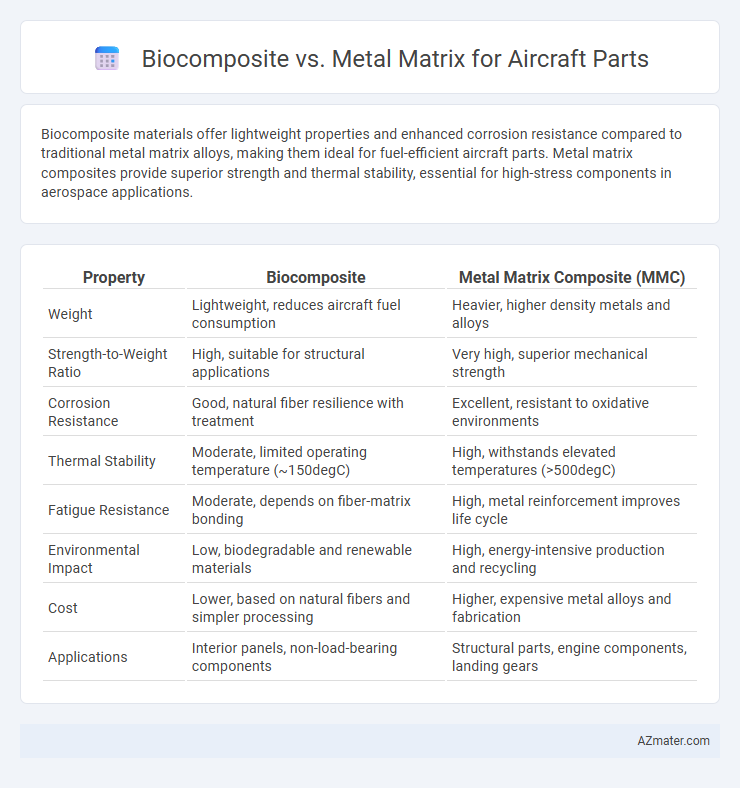Biocomposite materials offer lightweight properties and enhanced corrosion resistance compared to traditional metal matrix alloys, making them ideal for fuel-efficient aircraft parts. Metal matrix composites provide superior strength and thermal stability, essential for high-stress components in aerospace applications.
Table of Comparison
| Property | Biocomposite | Metal Matrix Composite (MMC) |
|---|---|---|
| Weight | Lightweight, reduces aircraft fuel consumption | Heavier, higher density metals and alloys |
| Strength-to-Weight Ratio | High, suitable for structural applications | Very high, superior mechanical strength |
| Corrosion Resistance | Good, natural fiber resilience with treatment | Excellent, resistant to oxidative environments |
| Thermal Stability | Moderate, limited operating temperature (~150degC) | High, withstands elevated temperatures (>500degC) |
| Fatigue Resistance | Moderate, depends on fiber-matrix bonding | High, metal reinforcement improves life cycle |
| Environmental Impact | Low, biodegradable and renewable materials | High, energy-intensive production and recycling |
| Cost | Lower, based on natural fibers and simpler processing | Higher, expensive metal alloys and fabrication |
| Applications | Interior panels, non-load-bearing components | Structural parts, engine components, landing gears |
Introduction: Biocomposites and Metal Matrix in Aerospace
Biocomposites in aerospace combine natural fibers with polymer matrices, offering lightweight and corrosion-resistant properties that enhance fuel efficiency and reduce emissions. Metal matrix composites (MMCs) integrate reinforcing materials such as ceramic fibers or particles into metal alloys, delivering superior strength, thermal stability, and wear resistance essential for high-performance aircraft components. The choice between biocomposites and MMCs hinges on balancing weight reduction, mechanical demands, and environmental sustainability in modern aircraft design.
Material Composition and Structure Comparison
Biocomposite aircraft parts typically consist of natural fibers such as flax or hemp embedded in a polymer matrix, offering lightweight properties and enhanced sustainability compared to traditional materials. Metal matrix composites (MMCs) combine metal alloys like aluminum or titanium with ceramic reinforcements such as silicon carbide, resulting in superior mechanical strength and thermal resistance. The heterogeneous structure of MMCs provides higher durability under stress, whereas biocomposites excel in reducing weight and environmental impact.
Weight and Density Considerations
Biocomposites offer significantly lower density compared to metal matrix composites, reducing overall aircraft weight and enhancing fuel efficiency. Metal matrix composites typically have higher density but provide superior strength and thermal resistance, making them suitable for high-stress components. The trade-off between biocomposites' lightweight properties and metal matrices' structural performance is crucial in optimizing aircraft part design for weight-sensitive applications.
Mechanical Strength and Performance
Biocomposites offer a lightweight alternative to metal matrix composites (MMCs) in aircraft parts, providing high specific strength and excellent fatigue resistance, which enhances fuel efficiency without compromising durability. Metal matrix composites exhibit superior mechanical strength, high thermal stability, and exceptional wear resistance, making them ideal for critical structural components subjected to intense mechanical loads and high temperatures. The choice between biocomposite and metal matrix materials depends on the required balance between weight savings and mechanical performance for specific aerospace applications.
Thermal Resistance and Conductivity
Biocomposite materials in aircraft parts offer superior thermal resistance due to their low thermal conductivity, making them ideal for insulating components exposed to high temperatures. Metal matrix composites (MMCs) provide enhanced thermal conductivity, enabling efficient heat dissipation critical for engine and structural applications. Selecting between biocomposites and MMCs depends on balancing the need for thermal insulation versus effective heat transfer in specific aircraft parts.
Corrosion and Environmental Durability
Biocomposite materials in aircraft parts offer superior corrosion resistance compared to metal matrix composites, as they do not oxidize or rust, enhancing long-term environmental durability. Metal matrix composites, while stronger and more heat-resistant, require protective coatings to mitigate corrosion from moisture and salt exposure in aerospace environments. The choice hinges on balancing biocomposites' lightweight, corrosion-resistant properties against metal matrix composites' mechanical strength and thermal stability under variable environmental conditions.
Cost Analysis and Manufacturing Processes
Biocomposite materials offer significant cost advantages over metal matrix composites (MMCs) in aircraft parts due to lower raw material expenses and reduced energy consumption during manufacturing. The production of biocomposites typically involves simpler processes like compression molding or resin transfer molding, which are less capital-intensive compared to the high-temperature, high-pressure methods required for MMC fabrication such as powder metallurgy or infiltration. Life cycle cost analysis also favors biocomposites because of their corrosion resistance and reduced maintenance needs, ultimately lowering the total cost of ownership for aerospace applications.
Sustainability and Environmental Impact
Biocomposite materials in aircraft parts offer significant sustainability benefits due to their renewable natural fibers and lower carbon footprint compared to metal matrix composites, which rely on energy-intensive metal extraction and processing. Biocomposites exhibit reduced end-of-life environmental impact through biodegradability and easier recycling, whereas metal matrices often pose challenges related to resource depletion and toxicity in disposal. The shift towards biocomposites supports circular economy principles, minimizing greenhouse gas emissions and promoting eco-friendly aviation manufacturing.
Applications of Biocomposite vs Metal Matrix in Aircraft
Biocomposites are increasingly used in aircraft interiors and non-structural components due to their lightweight, corrosion resistance, and environmental sustainability, reducing overall aircraft weight and fuel consumption. Metal matrix composites (MMCs) are preferred for structural components such as engine parts, landing gear, and airframe sections because of their superior strength, high-temperature resistance, and wear durability. The choice between biocomposites and MMCs depends on balancing mechanical performance requirements with sustainability goals and cost-effectiveness in aviation manufacturing.
Future Trends and Innovations in Aerospace Materials
Biocomposites are emerging as lightweight, sustainable alternatives to traditional metal matrix composites in aircraft parts, offering improved fuel efficiency and reduced carbon emissions. Innovations in nanotechnology and fiber reinforcement are enhancing the mechanical properties and thermal stability of biocomposites, enabling their use in critical aerospace components. Future trends indicate a growing integration of hybrid materials combining biocomposites with metal matrices to optimize strength-to-weight ratios and durability for next-generation aircraft design.

Infographic: Biocomposite vs Metal Matrix for Aircraft Part
 azmater.com
azmater.com